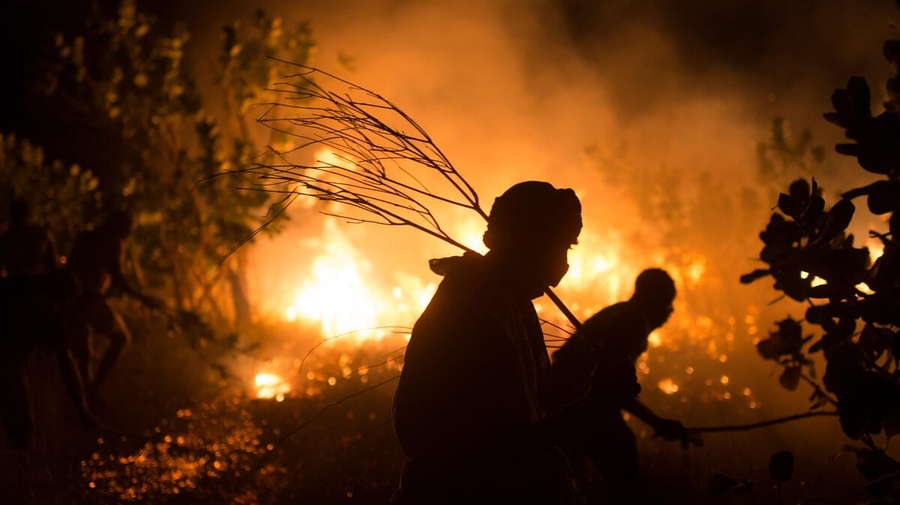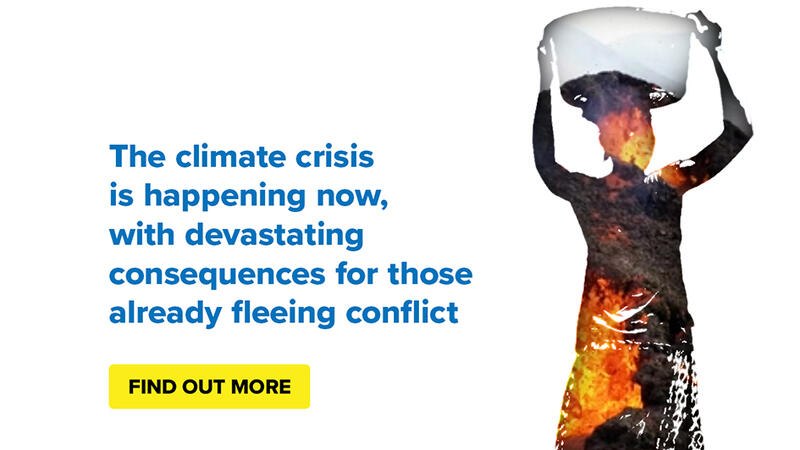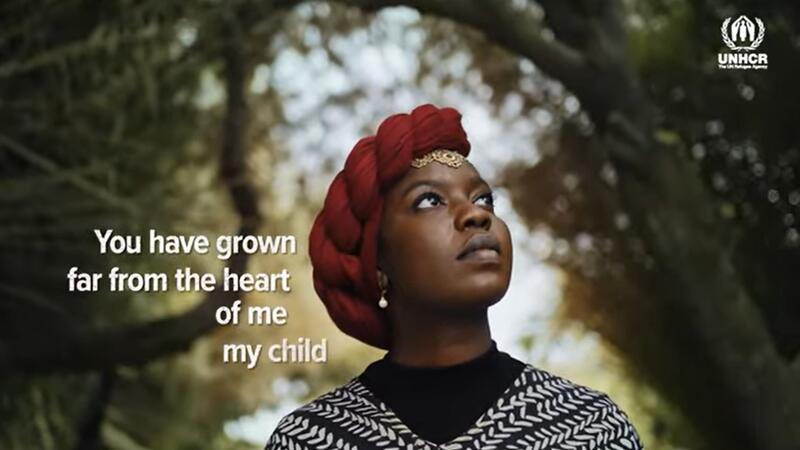Climate change and disaster displacement
Climate change and disaster displacement
UNHCR is providing protection and assistance to many refugees and other people displaced by the effects of climate change, as well as helping them increase their resilience to future disasters.
At the 26th UN Climate Change Conference of the Parties (COP26) UNHCR hopes that all parties work together to deliver on securing a global net zero, mobilize finance and adapt to protect communities and natural habitats. UNHCR is urging all parties to:
- combat the growing and disproportionate impacts of the climate emergency on the most vulnerable countries and communities — in particular those displaced and their hosts;
- support vulnerable countries and communities in their efforts to rapidly scale up prevention and preparedness measures to avert, minimize and address displacement.
The climate crisis is a human crisis. It is driving displacement and makes life harder for those already forced to flee.
Entire populations are already suffering the impacts of climate change, but vulnerable people living in some of the most fragile and conflict-affected countries are often disproportionately affected.
Refugees, internally displaced people (IDPs) and the stateless are on the frontlines of the climate emergency. Many are living in climate “hotspots”, where they typically lack the resources to adapt to an increasingly hostile environment. We must act now to support those most in need to resist the increasing violence of the climate crisis.
UNHCR is providing protection and assistance to many refugees and other people displaced by the effects of climate change, as well as helping them increase their resilience to future disasters.
The impacts of climate change are numerous and may both trigger displacement and worsen living conditions or hamper return for those who have already been displaced. Limited natural resources, such as drinking water, are becoming even scarcer in many parts of the world that host refugees. Crops and livestock struggle to survive where conditions become too hot and dry, or too cold and wet, threatening livelihoods. In such conditions, climate change can act as a threat multiplier, exacerbating existing tensions and adding to the potential for conflicts.
Hazards resulting from the increasing intensity and frequency of extreme weather events, such as abnormally heavy rainfall, prolonged droughts, desertification, environmental degradation, or sea-level rise and cyclones are already causing an average of more than 20 million people to leave their homes and move to other areas in their countries each year.
Some people are forced to cross borders in the context of climate change and disasters and may in some circumstances be in need of international protection. Refugee and human rights law therefore have an important role to play in this area.
The Global Compact on Refugees, affirmed by an overwhelming majority in the UN General Assembly in December 2018, directly addresses this growing concern. It recognizes that “climate, environmental degradation and disasters increasingly interact with the drivers of refugee movements”.
We need to invest now in preparedness to mitigate future protection needs and prevent further climate caused displacement. Waiting for disaster to strike is not an option.
UNHCR’s role in addressing climate change and disaster-related displacement
In January 2020, the High Commissioner for Refugees appointed Andrew Harper as the Special Advisor on Climate Action. He drives UNHCR’s engagement on the climate emergency, serves as a global advocate, and is responsible for providing oversight and expertise to shape UNHCR's climate action agenda.
Our climate action is focused on three main areas:
1. Law and policy. Providing legal advice, guidance and support to the international community to develop enhanced protection for refugees and other people displaced in the context of disasters and climate change, and catalyzing international discussions on their rights.
2. Operations. We strive to improve the predictability of our engagement to anticipate and prepare for emergencies brought on by climate-related and other natural hazards, including through strong partnerships. We are committed to reducing environmental degradation in displacement settings and enhancing the preparedness and resilience of displaced people and host communities to the effects of climate change. Learn more about the Refugee Environmental Protection Fund, which will invest in impactful reforestation and clean cooking programs in climate-vulnerable refugee situations around the world. We incorporate climate and environmental consideration in our operational responses. We are also working to “green” our end-to-end supply chain and to improve our supply planning, as well as the sourcing, contents, manufacturing process, procurement and delivery and lifecycle management of core relief items and other UNHCR goods. Read our Operational Strategy for Climate Resilience and Environmental Sustainability 2022-2025 and the Strategy summary here.
3. UNHCR’s environmental footprint. Improving UNHCR’s environmental sustainability by reducing our greenhouse gas emissions and minimizing negative impacts on the environment.
View the strategic framework for climate action
How does climate change affect refugees? How does UNHCR help?
In 2020, UNHCR deployed teams to assist relief efforts in Central America and southern Mexico, where an estimated three million people had been affected by Hurricane Eta – one of the worst weather-related disasters in the region in the past two decades. When Tropical Cyclone Idai hit Mozambique, Zimbabwe and Malawi in March 2019, UNHCR relocated refugee families to safer shelters and provided them with tents, plastic sheeting, sanitation equipment and clean water. Similarly, UNHCR has been helping Rohingya refugees in southern Bangladesh to mitigate the effects of monsoon storms, flooding and landslides.
People already displaced for reasons other than disasters linked to hazards – including refugees, stateless people, and the internally displaced – often reside in climate change “hotspots” where they may be exposed to secondary displacement and reduced chances of being able to return home.
This is the case in the Sahel region, which is facing one of the fastest growing displacement crises in the world. In this region, intense and largely indiscriminate violence perpetrated by armed actors has forced almost 3 million people to flee both within countries and across borders. This growing humanitarian and protection emergency is exacerbating pre-existing challenges faced by the region, including climate change and environmental degradation.
UNHCR plays a leading role in the Global Protection Cluster for protecting and assisting people who are forcibly displaced inside their countries and cannot safely return home. When called upon to intervene, the organization can deploy emergency teams to support registration, documentation, family reunification and the provision of shelter, basic hygiene and nutrition.
Through its participation in global policy processes, UNHCR has enhanced its role in raising awareness about climate change as a driver of displacement and the need to address protection for refugees and other people displaced in the context of disasters. Since 2015, as a standing invitee to the Platform on Disaster Displacement (PDD) and a member of its advisory group, UNHCR has strengthened its collaboration with States, partners such as IOM, UNDRR, UNFCCC, WMO, UNDP and other key actors, to respond to these challenges.
PDD is a State-led initiative in support of the implementation of the Nansen Initiative Protection Agenda on cross-border disaster displacement, the Sendai Framework for Disaster Risk Reduction and the Paris Agreement. Areas of cooperation include policy coherence, knowledge sharing, awareness raising, support to operations, legal and normative guidance, support to disaster risk reduction, climate action, clean energy and environmental sustainability, with the issuing of the Words into Action guidelines as the latest example.
‘Climate refugees’?
A “refugee” is defined as a person who has crossed an international border “owing to well-founded fear of being persecuted for reasons of race, religion, nationality, membership of a particular social group or political opinion” (1951 Convention relating to the Status of Refugees). In some contexts, the definition extends to persons fleeing “events seriously disturbing public order” (1969 OAU Convention 1984 Cartagena Declaration). Climate change affects people inside their own countries, and typically creates internal displacement before it reaches a level where it displaces people across borders. However, there may be situations where the refugee criteria of the 1951 Convention or the broader refugee criteria of regional refugee law frameworks could apply. People may have a valid claim for refugee status, for example, where the adverse effects of climate change interact with armed conflict and violence. Building on its study 'In Harm’s Way’, in 2020, UNHCR issued Legal Considerations to guide interpretation and steer international discussion on such claims. Regardless, the term “climate refugee” is not endorsed by UNHCR, and it is more accurate to refer to “persons displaced in the context of disasters and climate change.”
Policy and normative development
Research and studies
- In-Depth Report | Planned Relocation in Asia: A Regional Snapshot (disasterdisplacement.org)
- In-Depth Report | Planned Relocation in the Pacific: A Regional Snapshot (disasterdisplacement.org)
- Report of Excom Warsaw International Mechanism on Loss and Damage associated with Climate Change Impacts 2018
- COP24 Decision of Excom Warsaw International Mechanism on Loss and Damage associated with Climate Change Impacts
- IDMC Global Report on Internal Displacement 2018
- WMO Statement on the State of the Global Climate in 2018
- Women on the move in a changing climate - Sierra Club
- "Nowhere to go" on the front lines of climate change - IRIN
- Platform on Disaster Displacement website
- Refword - Documents and Reports
- Communicating the Complexity of Displacement in a Changing Climate




